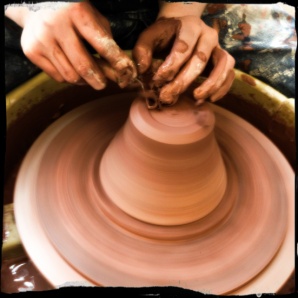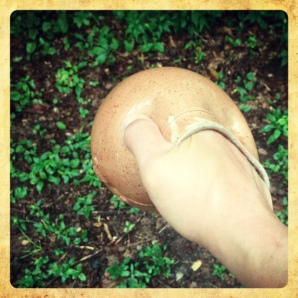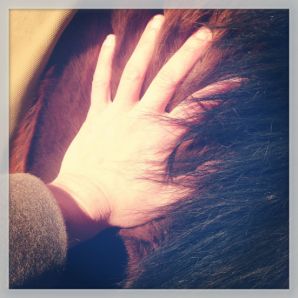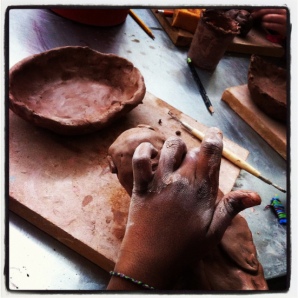Today, I found myself thinking a lot about hands.
At a workshop, we were asked to make something by hand, collaboratively, without skill or knowledge of the media, tools, or technique presented. It felt like a game – and, indeed, it was a lot of fun, with silly results shared in a cacophony of laughter.
A presumption of the day was that making is fun and engaging – and that creating product is some substance of project-based learning. Take some supplies, put them together to make something that answers a question, and build collaboration. A winning gesture towards teambuilding, and a practice gesture towards a topic-of-the-moment, the ‘Maker Movement.’
But our world is already saturated with product. In exercises like today’s, we make more product, and we do so hastily and without deep knowledge. Maybe some of these rapidly-constructed objects are considered novel and precious, earning display on a shelf in an office, or meriting story. But some also end up in the trash before the day is over. Others will collect dust or be abandoned, serving no functional or aesthetic purpose beyond the game of the day. We might forget the kindergarten rules of cleaning up after ourselves, in our rush to share and compete our results. And we may begin to presume that making does not require skill, practice, or in-depth knowledge of materials. When making becomes a game, it can erode at the deeper, knowledge- and practice-based work of the craftsman.
Don’t get me wrong – although I’m openly an introvert, I do value group work and collaboration. These skills are essential in real-life and some of my favorite ways to structure a class. But when the goal is investigating how groups work and collaborate, how does one make the product an investigation of how these processes work? By contrast, constructed objects can seem materials-intensive and a skim over the surface of craft. A parallel might be a collaborative math-based exercise in which you don’t know the methods and never get past guesswork – but have a lot of fun in the process. Valuable? Sure. But is this the best practice of learning in math, even in a project-based climate?
Worth mentioning: I was lucky to be part of a workshop last spring in which Greg Bamford of Leading is Learning helped us to investigate how collaboration works. The balloons we used in a making exercise were complete subtext to process and reflection. (Some of his resources are generously shared here.)
The day started with this quote, from Wendell Barry’s commencement address at Bellarmine University. (It was presented as a tweet – but the whole address is worth a read.)
The logic of vocation holds that there is an indispensable justice, to yourself and to others, in doing well the work that you are “called” or prepared by your talents to do.
Tonight, I feel like doing justice to my (current) vocation as someone who makes and teaches with my hands. In just a few days, it’s time to start convincing another year of students that it is worthwhile to investigate what the hand and the handmade object mean in today’s world. Thinkers like the ones I reference below motivate me for the task at hand. Pun intended.
—
The satisfactions of manifesting oneself concretely in the world through manual competence have been known to make a man quiet and easy. They seem to relieve him of the felt need to offer chattering interpretations of himself to vindicate his worth. He can simply point: the building stands, the car now runs, the lights are on. Boasting is what a boy does, because he has no real effect on the world. But the tradesman must reckon with the infallible judgment of reality, where one’s failures or shortcomings cannot be interpreted away. His well-founded pride is far from the gratuitous “self-esteem” that educators would impart to students, as though by magic.
Matthew Crawford, Shop Class as Soulcraft
—
Technique has a bad name; it can seem soulless. That’s not how people whose hands become highly trained view technique. For them, technique will be intimately linked to expression.
Richard Sennett, The Craftsman
—
This film was shot by a fellow dancer when Yvonne Rainer was confined to a hospital bed, recovering from major surgery and unable to dance.
—
Horses are measured in hands. It’s a valuable lesson. The world might be measured similarly, not only marking its size but the contributions that went into making it.
Brandon Som, blog post, Summer 2013
—
The essence of making with the hand is the wisdom of the body and its stored memory. It is our past history of tactile experiences that assist in guiding the hand…
When using the cup I imagine touching someone’s hand. Time and again studies have shown that when humans feel a connection through touch it is beneficial to their well-being. What are the experiences that make you feel most alive?
Chris Staley, The Hegemonic Eye: Can the Hand Survive?
—
The magic I felt when I first laid my hands on wet clay gave me the believe that I could do something interesting with my life. It opened up doors to meaning and possibility that showed me, for the first time, that I had talents and capabilities no one had seen before and that I had never dreamed of. I’m convinced that those insights not only gave me a vision of my future, they literally saved my life.
Bill Strickland, Make the Impossible Possible
—
Stu Kestenbaum, In Praise of Hands (poem)
—
Staley on Hands
—
Amusing aside: Seth Godin uses the phrase “on the other hand” a total of 765 times in his blog, as of an August 26 count.













